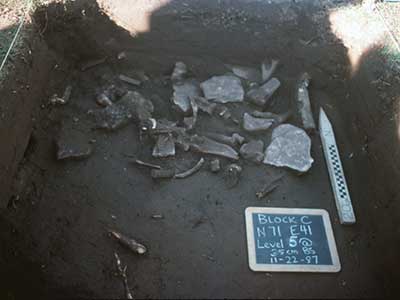Excavations at the fort site documented remnants of a stone chimney base of one of the fort's cabins. A small patch of compacted soil was identified as a dirt floor in front of the hearth inside the cabin. Artifacts dating to the late eighteenth century were found resting on top of this floor remnant, lying where they had been discarded over 200 years before. Fragments of English-made refined ceramic tablewares and red clay earthenware crockery, hand-wrought nails, buttons, lead ammunition and gunflints, and tobacco pipestems all offered hints about what people owned and used during their stay at the fort. For example, the gunflints and lead bullets underscored the importance of firearms for defense and for hunting. Tobacco pipestems indicated that some settlers were smokers and undoubtedly planted tobacco to sustain their habit.
A hearth found outside the cabin area contained a large quantity of wild and domestic animal bone. Analysis revealed that wild animal species, such as black bear, white-tailed deer, buffalo, elk, wild turkey and catfish, were eaten along with cow and pig by those living at Fort Boonesborough.
